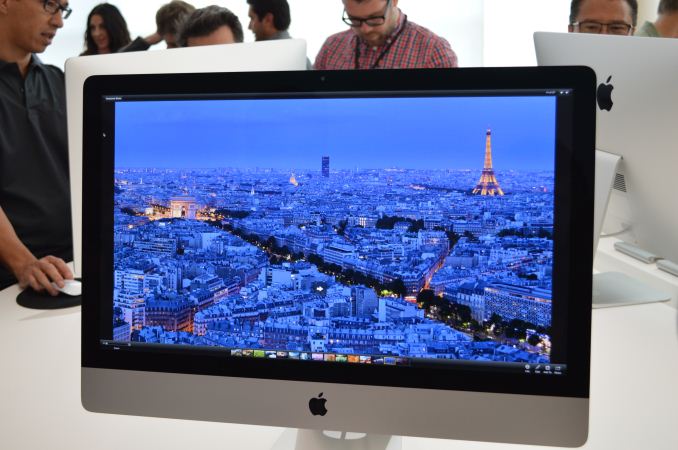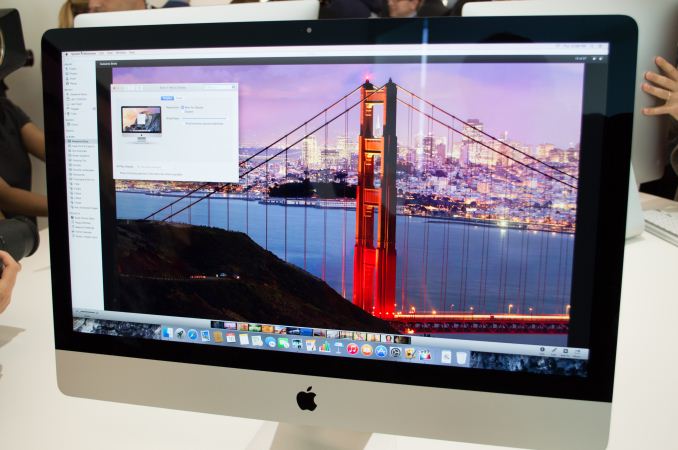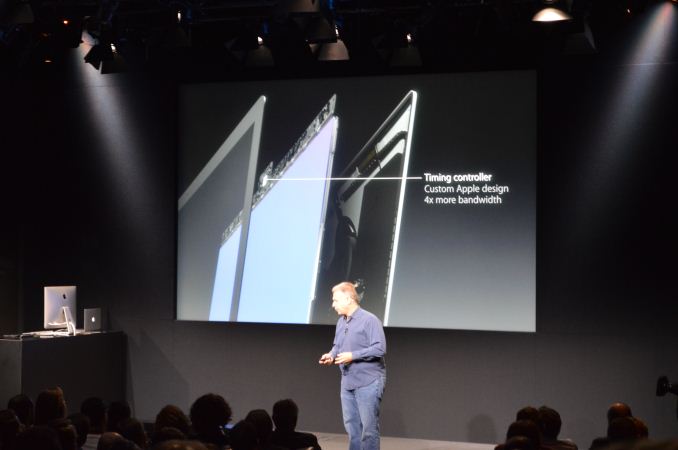Hands On: Apple's iMac with Retina Display
by Ryan Smith on October 16, 2014 4:15 PM EST
We just got done with our hands-on time with Apple’s new products, and we’ll start with what’s likely the sneakiest of them, the iMac with Retina Display.
Why “sneaky”? The answer is all in the HiDPI display, which Apple calls the “Retina 5K Display”. The retina display is definitely the star of the new iMac, as the rest of the hardware is largely a minor specification bump from last year’s model. In fact turned off you’d be hard pressed to tell the difference between the 2013 (non-retina) and new retina models, but the screen is immediately evident once on.
At 5120x2880 pixels, the new Retina 5K Display is precisely 4x the pixels of the 2560x1440 panel in last year’s model. What this means is that Apple can tap their standard bag of tricks to handle applications of differing retina capability and get all of it to look reasonably good. This also means that 2560x1440 content – including widgets – will scale up nicely to the new resolution. Apple does not discuss whom they have sourced the panel from, but given the timing it’s likely the same panel that is in Dell’s recently announced 27” 5K monitor.
Much more interesting is how Apple is driving it. Since no one has a 5K timing controller (TCON) yet, Apple went and built their own. This is the first time we’re aware of Apple doing such a thing for a Mac, but it’s likely they just haven’t talked about it before. In any case, Apple was kind enough to confirm that they are driving the new iMac’s display with a single TCON. This is not a multi-tile display, but instead is a single 5120x2880 mode.
This also means that since it isn’t multi-tile, Apple would need to drive it over a single DisplayPort connection, which is actually impossible with conventional DisplayPort HBR2. We’re still getting to the bottom of how Apple is doing this (and hence the sneaky nature of the iMac), but currently our best theory is that Apple is running an overclocked DisplayPort/eDP interface along with some very low overhead timings to get just enough bandwidth for the job. Since the iMac is an all-in-one device, Apple is more or less free to violate specifications and do what they want so long as it isn’t advertised as DisplayPort and doesn’t interact with 3rd party devices.
Update: And for anyone wondering whether you can drive the 5K display as an external display using Target Display Mode, Apple has confirmed that you cannot.
Meanwhile driving the new display are AMD’s Radeon R9 M290X and R9 M295X, which replace the former NVIDIA GTX 700M parts. We don’t have any performance data on the M295X, though our best guess is to expect R9 285-like performance (with a large over/under). If Apple is fudging the DisplayPort specification to get a single DisplayPort stream, then no doubt AMD has been helping on this matter as one of the most prominent DisplayPort supporters.
The rest of the package is very similar to the 2013 iMac. It comes with an Intel Haswell desktop class CPU paired with 8GB or more RAM, 802.11ac support, and Apple’s SSD + HDD Fusion drive setup. Apple now offers a higher speed CPU upgrade option that goes up to 4GHz (4.4GHz Boost) – likely the Core i7-4790K – that should make the high-end iMac decently more performant than last year’s model by about 10%.


















83 Comments
View All Comments
zepi - Friday, October 17, 2014 - link
There plenty of Pros for going with AMD. Though maybe not directly for the benefit of Apples customer.1) Apple is having a patent fight with Nvidia. I'm sure they are not happy with Nvidia.
2) Apple, Microsoft and Sony all want to see AMD around to have competition for Intel / Nvidia, Giving AMD business to keep it afloat helps, even if they sacrifice some performance
3) AMD has less leverage in price negotiations compared to Nvidia due to it's much poorer financial situation. Most likely they are willing to work with smaller margins just to stay alive. And they might be willing to do more customization job to get these deals, as they are really struggling.
Not to mention that not supporting CUDA on the OSX basically forces software vendors to write OpenCL support into their applications. They might hate it, but they don't really have good options except abandoning OSX all together which doesn't seem like an option as Apple has surprising marketshare in some sectors.
It'd be interesting if Apple bought Nvidia. Nvidia has a market cap of only about 10 Billions. Less than half a year of Apples profits...
ppi - Friday, October 17, 2014 - link
Apple would not buy nVidia, as Apple does not sell graphics cards and other components, only complete consumer devices. So why pay for entire well running business, when you need just their R&D?AMD could have won it due to their willingness(?) to customize the DP things. And maybe give some exclusivity on M295X + lower prices. It is also question whether 970M/980M were not late to the party.
iSayuSay - Saturday, October 18, 2014 - link
Same reason in why Apple built their own ARM chips for their iPhone and iPad? Why bother with the in house processor while Apple only sell complete devices? One definite answer is lower production costs. So I don't see no difference between Apple bought nVidia and Apple bought a few ARM design firms in the past.tipoo - Thursday, October 16, 2014 - link
I wonder how comparable the new Mac Mini and the 999 dollar Vizio 4K TV would be...Though that would be too massive for professional work maybe.CharonPDX - Thursday, October 16, 2014 - link
Not even close. The new Mac Mini is dual-core only, with Intel Iris (not Pro) graphics.If your workload is simple (view high-res data without GPU compute transforms,) then it would work fine. But if you do CPU-intense or GPU-intense things, the iMac will blow it out of the water.
jameskatt - Friday, October 17, 2014 - link
This is where Apple went backwards. The old Mac Mini could do a quad-core i7 CPU.TiGr1982 - Thursday, October 16, 2014 - link
According to their website,GPU can be not only new R9 M295X (4 GB VRAM), supposed to be some kind of Tonga GPU,
but also R9 M290X (4 GB VRAM), which is "good old Pitcairn/Curacao", if I'm not mistaken.
Didn't know Pitcairn/Curacao is 5K-capable. May be a new chip revision though.
Daniel Egger - Thursday, October 16, 2014 - link
Maybe someone can help me out here: Why are you so sure that they're using DP at all? I've never seen DisplayPort used to drive an internal display so far...TiGr1982 - Thursday, October 16, 2014 - link
There is embedded Display Port standard (eDP):http://en.wikipedia.org/wiki/DisplayPort#eDP
Though I'm not sure they're actually using it here.
Darkstone - Thursday, October 16, 2014 - link
Displayport was introduced in laptops around 2 years ago. Many of the ultrabooks have an eDP connector (eDP, embedded displayport, is the same as normal DisplayPort, but with an different form factor). All laptops with 3D panels also have an eDP connector, as well as most IPS panels. I would like an better display in met 15.6" laptop, but the only IPS panel with lvds available in this form factor is the sony orangegate panel. At least that was the case about one year ago.